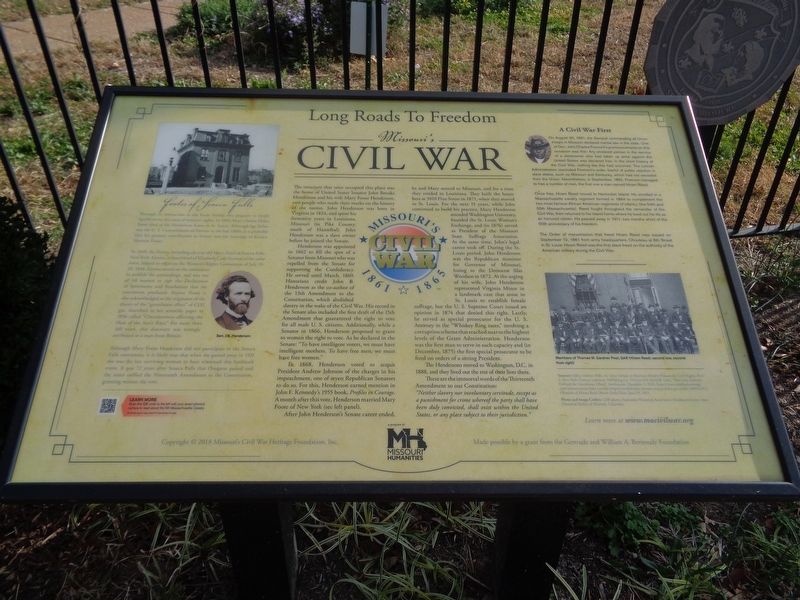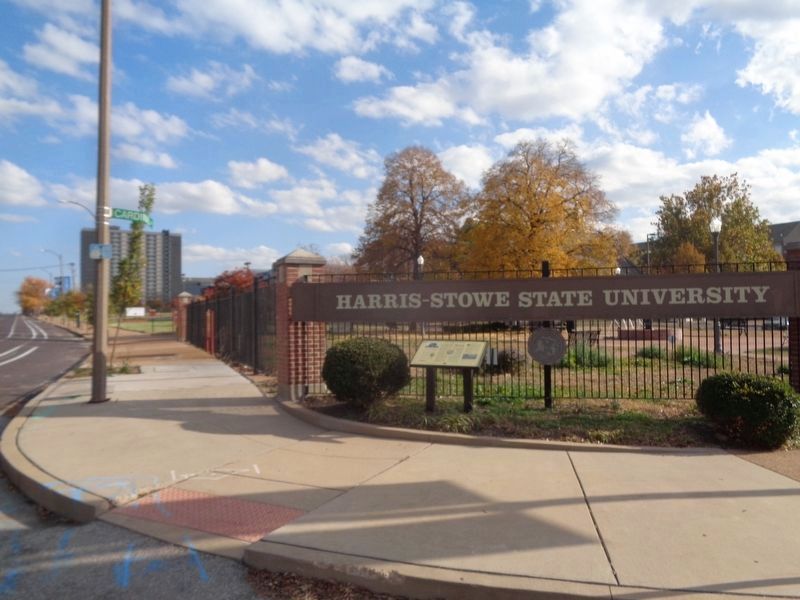Midtown in St. Louis, Missouri — The American Midwest (Upper Plains)
Long Roads To Freedom
Missouri's Civil War
The structure that once occupied this place was the home of United States Senator John Brooks Henderson and his wife Mary Foote Henderson, two people who made their marks on the history of the nation. John Henderson was born in Virginia in 1824, and spent his formative years in Louisiana, Missouri (in Pike County, south of Hannibal). John Henderson was a slave owner before he joined the Senate.
Henderson was appointed in 1862 to fill the spot of a Senator from Missouri who was expelled from the Senate for supporting the Confederacy. He served until March, 1869. Historians credit John B. Henderson as the co-author of the 13th Amendment to the Constitution, which abolished slavery in the wake of the Civil War. His record in the Senate also included the first draft of the 15th Amendment that guaranteed the right to vote for all male U.S. citizens. Additionally, while a Senator in 1866, Henderson proposed to grant to women the right to vote. As he declared in the Senate: "To have intelligent voters, we must have intelligent mothers. To have free men, we must have free women."
In 1868, Henderson voted to acquit President Andrew Johnson of the charges in his impeachment, one of seven Republican Senators to do so. For this, Henderson earned mention in John F. Kennedy's 1955 book, Profiles in Courage. A month after this vote, Henderson married Mary Foote of New York (see left panel).
After John Henderson's Senate career ended, he and Mary moved to Missouri, and for a time they resided in Louisiana. They built the house here at 3010 Pine Street in 1871, when they moved to St. Louis. For the next 15 years, while John continued to build his practice, Mary Henderson attended Washington University, founded the St. Louis Woman's Exchange, and (in 1876) served as President of the Missouri State Suffrage Association. At the same time, John's legal career took off. During the St. Louis period, John Henderson was the Republican nominee for Governor of Missouri, losing to the Democrat Silas Woodson in 1872. At the urging of his wife, John Henderson represented Virginia Minor in a landmark case that arose in St. Louis to establish female suffrage, but the U.S. Supreme Court issued an opinion in 1874 that denied this right. Lastly, he served as special prosecutor for the U.S. Attorney in the "Whiskey Ring cases," involving a corruption scheme that reached near to the highest levels of the Grant Administration. Henderson was the first man to serve in such capacity and (in December, 1875) the first special prosecutor to be fired on orders of a sitting President.
The Hendersons moved to Washington, D.C. in 1888, and they lived out the rest of their lives there.
These
are the immortal words of the Thirteenth Amendment to our Constitution:
"Neither slavery nor involuntary servitude, except as a punishment for crime whereof the party shall have been duly convicted, shall exist within the United States, or any place subject to their jurisdiction."
Footes of Seneca Falls
Through its connection to the Foote family, this property is deeply significant to the cause of women's rights. In 1883, Mary's father Elisha Foote died at the Henderson home in St. Louis. Although her father was the U.S. Commissioner of Patents in the late 1860s, it is probably that his greatest contribution to history was his marriage to Eunice Newton Foote.
In 1848, the Footes, including six year old Mary, lived in Seneca Falls, New York. Eunice, a close friend of Elizabeth Cady Stanton of the same town, helped to organize the Women's Rights Convention of July 19-20, 1848. Eunice served on the committee to publish the proceedings, and was one of 68 women to sign the Declaration of Sentiments and Resolutions that the convention produced. Eunice Foote is also acknowledged as the originator of the theory of the "greenhouse effect" of CO2 gas, described in her scientific paper in 1856 called "Circumstances affecting the Heat of the Sun's Rays." For more than 160 years, this discovery was wrongly attributed to a man from Britain.
Although Mary Foote Henderson did not participate in the Seneca Falls convention, it is likely true that when she passed away in 1931 she was the last surviving woman to have witnessed this landmark event. It was 72 years after Seneca Falls that Congress passed and the states ratified the Nineteenth Amendment to the Constitution, granting women the vote.
A Civil War First
On August 30, 1861, the General commanding all Union troops in Missouri declared martial law in the state. One of Gen. John Charles Fremont's pronouncements on this occasion was this: Any enslaved person in the service of a slaveowner who had taken up arms against the United States was declared free. In the short history of the Civil War, nothing like this had occurred. The Lincoln Administration rescinded Fremont's order, fearful of public reaction in slave states, such as Missouri and Kentucky, which had not seceded from the Union. Nevertheless, in September, 1861, Fremont managed to free a number of men, the first one a man named Hiram Reed.
Once free, Hiram Reed moved to Nantucket Island. He enrolled in a Massachusetts cavalry regiment formed in 1864 to complement the two most famous African American regiments of infantry (the 54th and 55th Massachusetts). Reed fought throughout the remainder of the Civil War, then returned to his island home where he lived out his life as an honored citizen. He passed away in 1911, two months short of the 50th anniversary of his freedom.
The Order of manumission that freed Hiram Reed was issued on September 12, 1861 from army headquarters, Chouteau at 8th Street in St. Louis. Hiram Reed was the first slave freed on the authority of the American military during the Civil War.
Erected 2018 by Missouri's Civil War Heritage Foundation, Inc. and Missouri Humanities.
Topics and series. This historical marker is listed in these topic lists: Abolition & Underground RR • African Americans • War, US Civil • Women. In addition, it is included in the Missouri’s Civil War series list.
Location. 38° 38.102′ N, 90° 13.421′ W. Marker is in St. Louis, Missouri. It is in Midtown. Marker is at the intersection of Olive Street and Cardinal Avenue, on the right when traveling east on Olive Street. Touch for map. Marker is at or near this postal address: 3106 Olive St, Saint Louis MO 63114, United States of America. Touch for directions.
Other nearby markers. At least 8 other markers are within walking distance of this marker. Stearns-Knight Building (about 400 feet away, measured in a direct line); Locomobile Building (about 400 feet away); Dodge-Reo Building (about 400 feet away); Stutz Building (about 400 feet away); Moon Building (about 500 feet away); Ford Building (about 600 feet away); Nash Building (about 600 feet away); Camp Jackson (about 600 feet away). Touch for a list and map of all markers in St. Louis.
Regarding Long Roads To Freedom. The website address (www.mocivilwar.org) on the marker for Missouri's Civil War Heritage Foundation, Inc. is inaccessible as of November 2020.
Also see . . .
1. John B. Henderson on Wikipedia. (Submitted on November 7, 2020, by Jason Voigt of Glen Carbon, Illinois.)
2. Mary Foote Henderson on Wikipedia. (Submitted on November 7, 2020, by Jason Voigt of Glen Carbon, Illinois.)
Credits. This page was last revised on January 30, 2023. It was originally submitted on November 7, 2020, by Jason Voigt of Glen Carbon, Illinois. This page has been viewed 280 times since then and 23 times this year. Photos: 1, 2. submitted on November 7, 2020, by Jason Voigt of Glen Carbon, Illinois.

